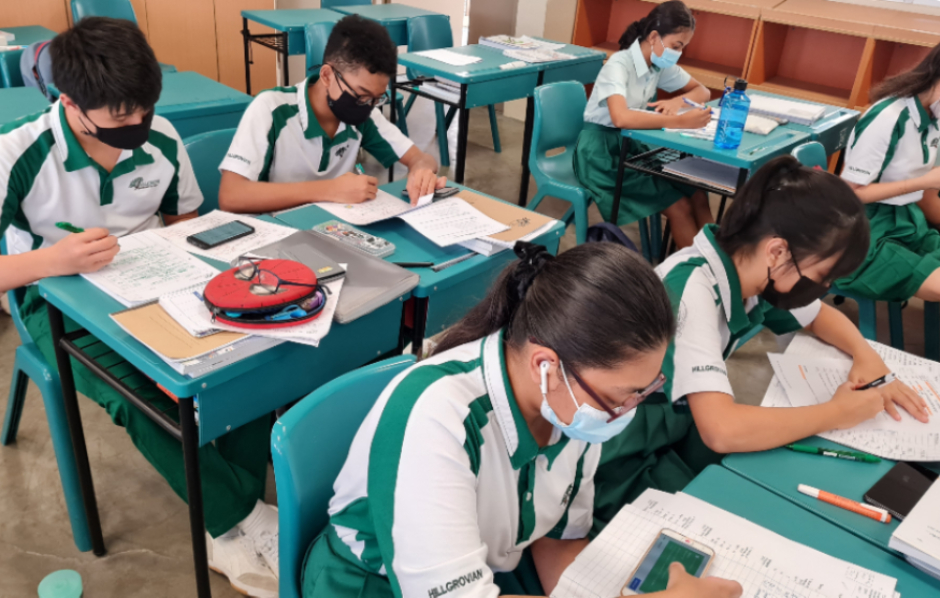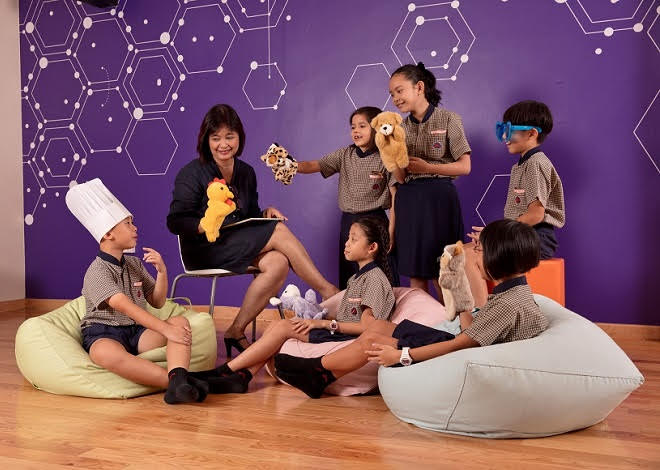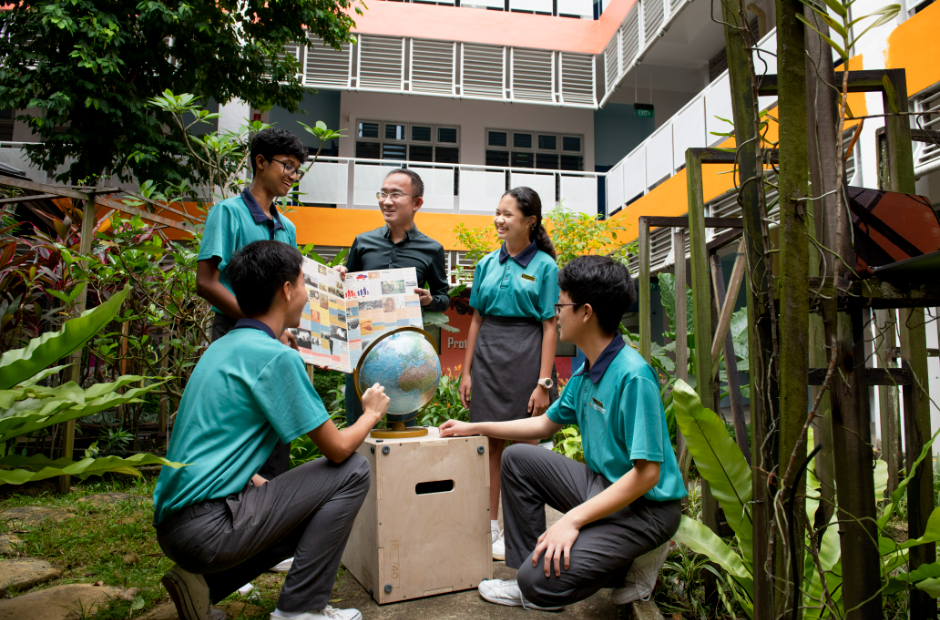Miss Tay Hui Cheng, St Anthony’s Canossian Secondary School, President’s Award for Teachers 2022 Recipient
The characters borrowed from the world of Chinese mythology are brought to life in an online game produced by educator Tay Hui Cheng to – yes, you guessed right – help students learn culture and language all in one app.
Hui Cheng, the Head of Department (HOD) for Mother Tongue (MT) at St. Anthony’s Canossian Secondary School, is the brain behind the innovative game titled Chinese GO!, which was designed in 2018 to help students master the Chinese language progressively through gamification.
During the COVID-19 pandemic, she also developed engaging Powtoon video clips for the same purpose – to make Chinese language learning fun for her students away from the classroom. With online learning, she found that she could not teach the way she used to and needed lots of engaging classroom activities to keep lessons interesting. “Every subject was basically fighting for air time and attention from the children, and my recorded Chinese lessons were simply not getting watched,” she shares with disarming honesty.
As HOD, she knew that she needed something radical to grab students’ attention and hook their interest. Since the students were digital natives who had grown up with technology, she wanted to deliver her lessons in the most engaging manner, leveraging the affordances of technology. While this was outside her comfort zone, she realised it had to be done. She had to find the resources and inspire her team to create the content.

Hui Cheng taught herself how to use the apps and programmes to produce the clips. These clips comprised infographics, mindmaps and statistics to familiarise students with current affairs and equip them with key Chinese vocabulary to become effective communicators.
Each eight-minute Powtoon video clip took up to three days to produce, as Hui Cheng aimed for clean and crisp audio tracks and smooth transitions from segment to segment. How did she pick up the skills for this? From YouTube! “If the clips are meant for students to watch and learn from, the students must want to watch them, and it is my job to create the most engaging videos I can,” she explains matter-of-factly.
None of these materials went to waste when the pandemic restrictions were lifted and students could attend school in person. Because of how engaging the materials were, they were readily incorporated into the department’s bank of hybrid teaching resources.
Bringing together talents from across the teaching staff
Back in 2018 before the pandemic, Hui Cheng was already exploring ways to engage students using technology. The app, Chinese GO! has all the gamification features that draw students in. As students complete topical bite-sized Chinese language tasks, such as fill in the blanks and cloze passages — the kind that students typically drag their feet at completing in real life — they earn experience points. This motivates them to do more of the tasks to earn more points to level up and evolve their characters.
These tasks were created by Hui Cheng and her team. It was no mean feat considering the scale of it. They came up with 800 different vocabulary cards spread across over twenty broad topics, for the students to learn key vocabulary and skills. The teachers also recorded the accompanying audio clips.

This project then extended beyond the Mother Tongue department.
“Staff from different departments came together to volunteer their knowhow,” says Hui Cheng. “We had a young Music teacher who composed the original background music for the game; English teachers who provided the English voice-over for the promotional video and helped me to clean up the sound quality of the trailer; and we even had an Art teacher who linked me up with the ex-student who ended up designing the characters in the game. I may have come up with the idea, but it was really the school’s effort. I’m really very grateful.”
Students were directed to download and use the game, with subscriptions paid by the school. The eEnd user survey shed light on students’ reception and areas for improvement which helped the team make refinements. Hui Cheng learned from a student that her classmates designated every Tuesday “Speak Chinese Day” as a result of their interest in the game. “And she wasn’t even a student I taught!”, Hui Cheng shares with delight.
“I always tell my students that the game is truly born out of love for them from all the teachers in the school!” she says cheerily. This teaching and learning innovation went on to clinch the Innergy Gold Award in 2018 and has been evolving since.
“If the clips are meant for the students to watch and learn from, the students must want to watch it, and it is my job to create the most engaging videos I can.”
Here’s another pleasant surprise: students whom Hui Cheng does not teach will approach her to thank her for her efforts in producing these resources and developing Chinese GO! for them.
For all these tech solutions, Hui Cheng is quick to add that she is no tech whiz in disguise: “I don’t even have an active Facebook account!” she confesses with a laugh. Then what made her venture into producing her own tech-powered materials and how did she pull it off? “Because I find that it is the best way I can think of to help my students learn Chinese.”
Differentiated learning and emotional readiness
Scratch any thought of technology being cold. When Tay Hui Cheng talks about the mobile game she invented to teach Chinese, she exudes the warmth of a mother excited to connect with her teens on their favourite platforms.
Language mastery aside, Hui Cheng, who has 18 years of teaching experience, believes it is her job as a teacher to help her students be emotionally ready to learn. “Students who come into the classroom with an unsettled heart and clouded mind will not be able to learn properly.”
It is little wonder then that Hui Cheng’s classroom lessons are often life lessons in themselves. She may bring up news items for discussion, or matters that may affect the students’ mental health. This opens channels for communication and avails help to any student in need. Some students have responded by privately approaching her for advice and emotional support.
Says Hui Cheng, “I went through a tough time making friends when I had to change classes in Primary 6, and felt really down and alone. While I managed to pull myself out of that state, it was really hard. It is my wish that my students will never have to go through what I went through.”
“People don’t care how much you know until they know how much you care”. This quote from Theodore Roosevelt explains why Hui Cheng goes the extra mile, which includes customising prayer and motivational cards for her students in the Catholic school.
“This is my way of helping students feel that they are noticed, that I care for them. I believe that all these little efforts will ultimately motivate them to learn better, because they feel like they are cared for.”






